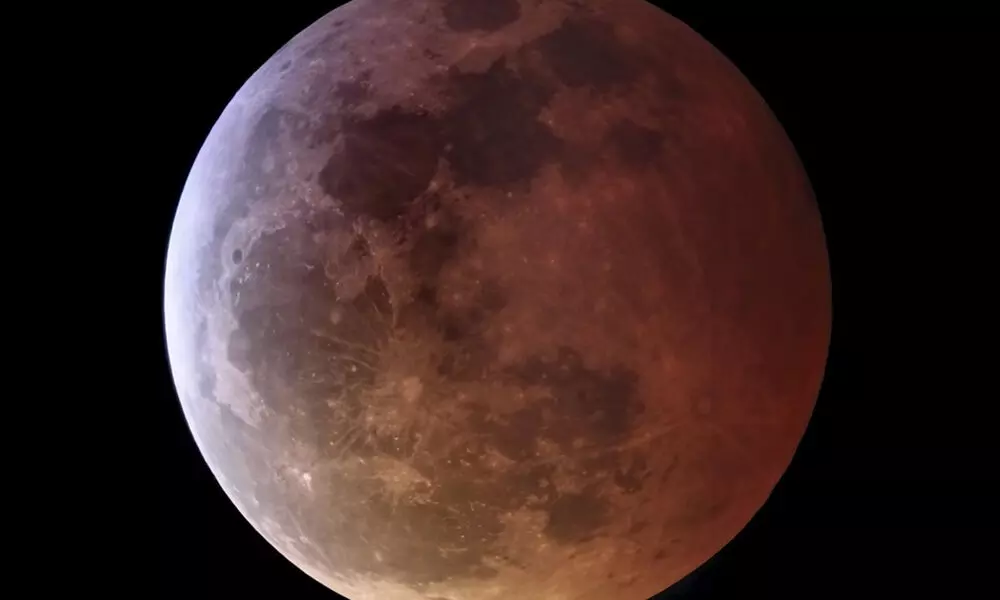Blood Moon 2021: Facts to Know about Lunar Eclipse

Blood Moon 2021: Facts to Know about Lunar Eclipse
Lunar Eclipse 2021 | Super Blood Moon 2021: This total lunar eclipse occurring on May 26 is the first total lunar eclipse in more than two years. This total lunar eclipse will not be visible in India.
Lunar Eclipse 2021 | Super Blood Moon 2021: The sky gazers will watch a total lunar eclipse on May 26, 2021 tomorrow. This phenomenon is also known as a Super Blood Moon, as the moon has a slightly reddish-orange colour and, since it is a full moon, the satellite will also look very large.
This one is the first total lunar eclipse to occur in more than two years. The last time a lunar eclipse took place was on January 21, 2019.
1. What is a total lunar eclipse?
A total lunar eclipse occurs when the Earth comes between the sun and the moon, blocking the sun's rays from reaching the satellite directly. As a result, the moon completely gets overshadowed by the Earth, called a total lunar eclipse.
2. What is Blood Moon?
A blood Moon appears when the Moon's surface turns reddish since the Earth completely blocks direct sunlight from reaching the Moon, and only the light reflected from the lunar surface is refracted by the Earth's atmosphere. Thus, it can be seen with the naked eye, without the need for any special equipment. That said, the experience would be better if you could see the eclipse through a telescope.
3. Where all this lunar eclipse is visible?
The lunar eclipse will be visible in America, Australia, and East Asia. It will also be visible from parts of the Pacific, Atlantic, and Indian Oceans. Those living in eastern Australia, New Zealand, and the Pacific Islands, including Hawaii, will witness both the total and partial eclipse.
According to the NASA website, the total eclipse will be visible around moonset in the western continental United States, Canada, Mexico, most of Central America and Ecuador, western Peru, southern Chile and Argentina. Across the Asia-Pacific Basin, the total eclipse will be visible just after the moonrise, the space agency claims.
4. Will this lunar eclipse be visible in India?
No, this total lunar eclipse will not be visible in India. Only the partial eclipse, "which occurs when the Moon enters and leaves the Earth's shadow," will be visible in eastern parts of India, Nepal, western China, Mongolia and eastern Russia.
5. Can we watch the live stream of the lunar eclipse?
Although the total lunar eclipse will not be visible in India, we can still watch the event. Several YouTube channels are set up to broadcast live images of the total lunar eclipse and set a countdown for the event. The first total lunar eclipse will begin at 2:17 pm based on Indian Standard Time (IST) and will be viewable until 7:19 pm. The Dateandtime website has also set up a live feed for it. NASA has yet to announce a live broadcast. The total duration of this eclipse is three hours, and the total phase in which the Moon is completely blocked will be about 15 minutes.
6. What are the lunar eclipse timings?
According to NASA notes, the 2021 blood moon or total lunar eclipse this year will last three hours and seven minutes in total, including the partial eclipse and the total eclipse. However, the total lunar eclipse will be visible for around 15 minutes. It will start at 2:17 pm IST(08:47 am UTC). However, the full eclipse will appear at 4:41 pm IST (11:11 am UTC) and will peak at 4:48 pm IST (11:18 pm UTC) and will remain in its full state until 4:55 pm IST (11:25 am UTC). Finally, the full lunar eclipse will end at 7:19 am IST (01:49 pm UTC).
7. Why are we calling this lunar eclipse is a "blood moon"?
This one is a Super Blood Moon; the moon looks reddish-orange and also very large. It is large because it is a full moon, and the satellite is closer to Earth. NASA also says that not all supermoons are blood or red-looking moons because an eclipse is not happening simultaneously in all cases. But this is different.
"The eclipsed Moon is dimly illuminated by red-orange light leftover from all of the sunsets and sunrises occurring around the world at that time. The more dust or clouds in Earth's atmosphere during the eclipse, the redder the Moon will appear," explains the page.
8. When is the next Lunar Eclipse?
After the next Blood Moon, the next total lunar eclipse is scheduled for May 16, 2022. There will also be a partial lunar eclipse on November 19.
9. Lunar Eclipse 2021: Types of Lunar Eclipses
There are three kinds of lunar eclipse - Total lunar eclipse, partial lunar eclipse and penumbral lunar eclipse.




















